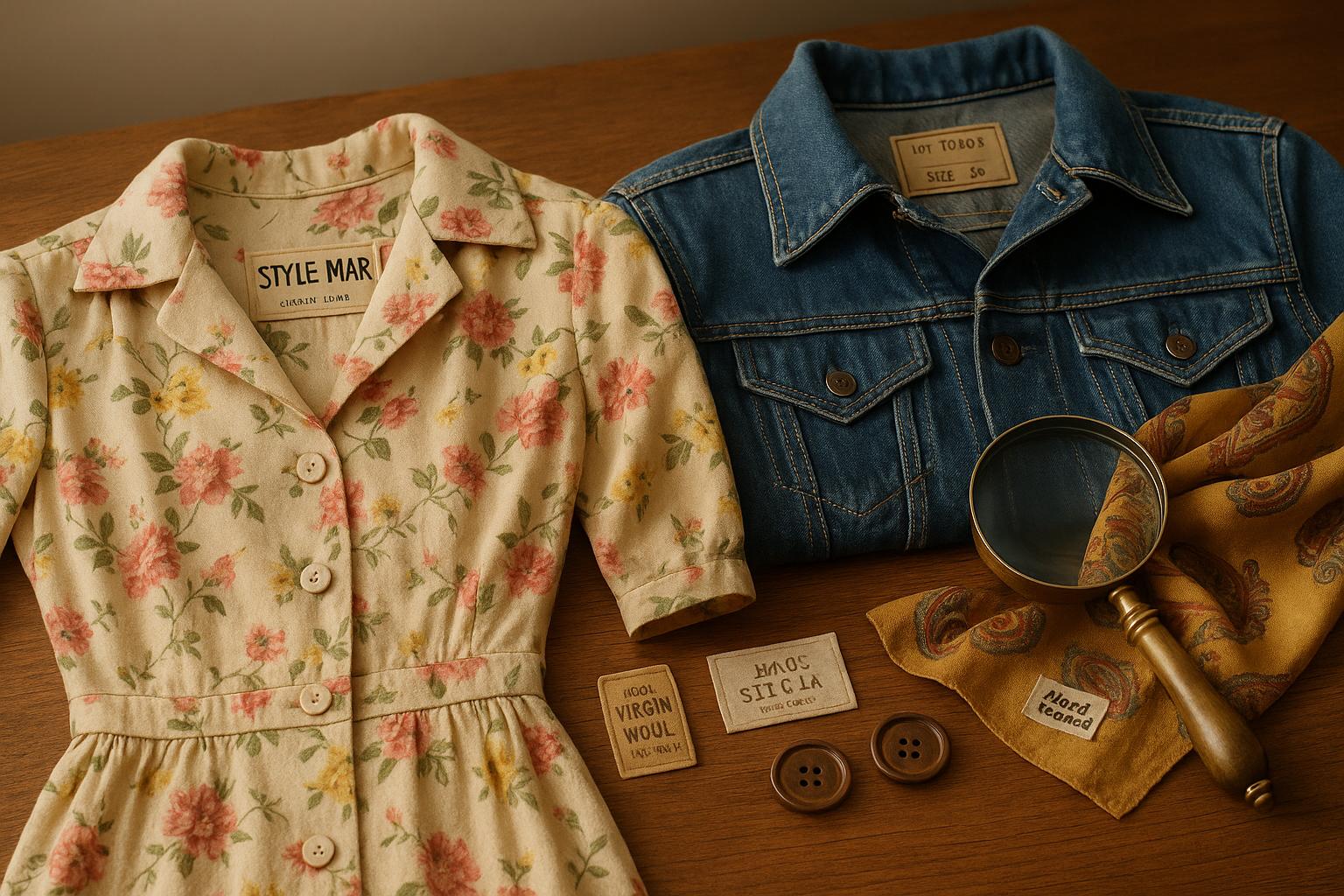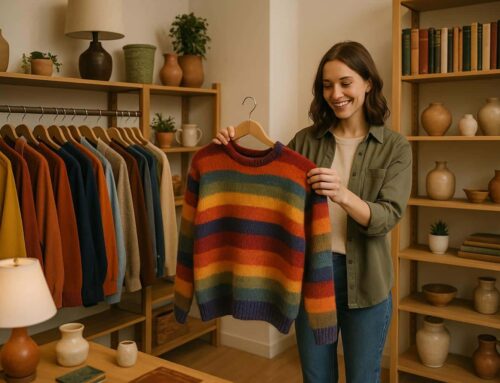Want to find real vintage clothing? Here’s a quick guide to help you identify genuine vintage pieces and avoid modern reproductions:
- Age Range: Vintage clothing is 20–99 years old (1925–2005 as of 2025). Anything older is considered antique; anything newer is referred to as retro or reproduction.
- Labels & Tags: Look for union labels, RN numbers (introduced in 1952), and country-of-origin clues (e.g., “Made in U.S.A.” or defunct countries like Yugoslavia). Care labels became mandatory in 1972.
- Fabrics: Pre-1960s clothing typically used natural fibers such as cotton, silk, and wool. Synthetics like polyester became popular in the 1970s.
- Construction: Check stitching (French seams pre-1940s, pinked seams in the 1950s, serged seams from the 1960s), generous seam allowances, and sturdy hardware like metal zippers (pre-1965).
- Natural Aging: Authentic vintage shows uneven fading, random wear patterns, and natural patina. Modern reproductions often have uniform distressing or artificial aging.
Quick Tip: Visit thrift stores like City Thrift to practice these techniques and find affordable vintage treasures while supporting sustainability.
| Clue | Era/Indicator |
|---|---|
| Union Labels | ILGWU labels can date clothing from 1900–1995 |
| Fabric | Natural fibers dominated pre-1960s |
| Zippers | Metal pre-1965; plastic post-1960s |
| Care Labels | Introduced in 1972 |
| Country Labels | Defunct countries (e.g., Yugoslavia pre-1999) |
Start using these tips to confidently spot true vintage pieces!
How to Read Labels and Tags
Labels and tags are like a treasure map when it comes to identifying vintage clothing. They can reveal the age and origin of a piece, helping you distinguish authentic vintage items from modern reproductions. If you’re thrifting at places like City Thrift, knowing how to read these markers can make all the difference.
Reading Manufacturer and Union Labels
Manufacturer and union labels hold key details about a garment’s authenticity and history. One of the first things to check is the fabric of the label itself. Older labels were often made from sturdy materials, unlike the thinner or printed labels you’ll find on modern clothing. This difference reflects the higher production standards of earlier times.
RN numbers are another useful tool for dating clothing. These registration numbers first appeared in 1952, and the number of digits can help pinpoint the decade of production. Cross-referencing these numbers in RN databases can provide more detailed information about the manufacturer and its timeline.
For women’s clothing, International Ladies’ Garment Workers’ Union (ILGWU) labels are especially helpful. These labels have gone through eight design changes since 1900, making it possible to date garments within a 10-20 year range. For instance, an ILGWU label featuring “UNION LABEL” above a scalloped crest and “AFL-CIO” but lacking the “R” symbol likely dates from 1955 to 1963.
Other clues include the absence of care instructions, which suggests the item was made before 1972, when standardized care labels became mandatory. Similarly, standardized sizes and fiber content labeling began around 1958, and the Woolmark logo first appeared in 1964.
Country-of-Origin Clues
The country of origin printed on a label can also reveal a lot about a garment’s age. For example, labels that say “Made in U.S.A.” or feature American flag designs are typically from the 1970s, 1980s, or earlier. Finding these labels today is rare, making them strong indicators of vintage clothing.
Labels from defunct countries like “Yugoslavia”, “West Germany”, or “British Hong Kong” are even more telling. These names reflect political and geographical changes, generally dating the garment to before 1999. For example, “British Hong Kong” was used until the territory was handed back to China in 1999 after over a century of British rule.
Manufacturing trends also shifted by decade. According to vintage experts Carmen & Ginger:
“The chronological order for mass-produced (i.e.; not high end) overseas is (not exactly) but about 1960’s- Japan; 1970’s: Korea – Taiwan, 1980’s: Taiwan + some China + Eastern European (like the Yugoslavia you show); 1990’s Singapore, Malaysia, China, Indonesia start to become common…”
Labels reading “Made in Mexico” are worth noting as well. While modern clothing is still made in Mexico, vintage pieces with this label often date back to the 1950s, a time when Mexico was a popular travel destination for Americans.
Even the placement of the label can provide clues. Vintage labels typically display the country of origin prominently on the front, whereas modern labels often tuck this information behind the tag.
Font and Design Changes Over Time
Typography and label design have evolved significantly over the decades, offering another layer of insight. Early 1900s labels were simple, often just showing brand names and sizes, reflecting Art Nouveau and Art Deco styles. By the 1950s, labels became more decorative and informative, including fabric content and care instructions. The bold and diverse designs of the 1970s and 1980s marked a shift toward designer branding, with larger logos symbolizing luxury.
Changes in specific brands’ labels can also help narrow down dates. For instance, a Sears flannel shirt with a rectangular logo likely dates to the late 1970s or early 1980s, as Sears switched to a scripted logo in 1984. Similarly, Carhartt labels have evolved, with modern tags featuring larger logos and smaller text compared to those from the 1990s.
As vintage fashion expert Dominique de Merteuil puts it:
“Dating vintage clothes is both an art and a science and it can take years of experience to master the skill, but I want to focus on the main signs that will get you started.”
For a deeper dive, resources like the Vintage Fashion Guild’s website offer extensive brand information and label examples to help you sharpen your skills. Combining multiple clues will give you the most accurate assessment of a garment’s era.
Checking Fabrics and Materials
The fabric of a garment often tells the story of its era. Understanding the transition from natural fibers to synthetics can help you distinguish authentic vintage pieces from modern reproductions, especially when browsing thrift stores like City Thrift. Knowing how to assess the differences in fabric types is key to verifying a garment’s vintage origins.
Natural vs. Synthetic Fibers by Decade
Before the 1960s, most clothing was made from natural fibers like cotton, linen, silk, and wool. This was the peak period for natural fabrics, as synthetic options were both limited and costly. If a piece from the 1940s or 1950s feels entirely synthetic, it’s likely a reproduction.
The shift toward synthetic materials gained momentum after World War II, with polyester becoming more common. By the 1970s and 1980s, synthetics were at the forefront of fashion trends, so garments heavy in polyester from those decades are likely authentic to the era.
Natural and synthetic fibers also behave differently. Natural fabrics tend to wrinkle more easily, breathe better, and respond to temperature changes. If a garment feels stiff and doesn’t breathe, it might be a modern synthetic rather than a true vintage piece.
Weight, Texture, and Durability
The physical characteristics of fabric can also provide clues about its age. Vintage fabrics were often made with higher-quality materials such as silk, wool, and cotton. For example, vintage cotton t-shirts are thicker, sturdier, and soften over time, unlike the thinner, lighter cotton used today. Similarly, vintage polyester from the 1970s is thicker and coarser compared to its modern counterpart. A polyester shirt from that era will feel heavier and more substantial than a recent imitation.
Signs of wear and tear can also add to a vintage garment’s character, as long as the aging aligns with the piece’s era. Artificially distressed fabrics, on the other hand, are often a giveaway of modern reproductions.
Fiber Content Labels and Markings
Fiber content labels can serve as timestamps for dating vintage clothing. Labels became more common after the 1930s, and by 1958, listing fiber content was mandatory. Handmade garments or those from before the 1950s may lack labels entirely, which can itself be a clue to their age.
The specific materials listed on labels can also help pinpoint the garment’s era. Names like “Dacron Polyester” or “Qiana Nylon” were popular in certain decades before more generic terms became widespread.
Another useful tool is the Woolmark logo, introduced in 1964 to promote natural wool over synthetics. A wool garment without this logo likely predates 1939, while the presence of the logo confirms it was made after 1964.
For garments without labels, assessing the fabric’s feel can help determine whether it’s natural or synthetic. If you’re still unsure, a burn test on a small, hidden area can reveal the fiber type. Cotton burns quickly, leaving soft gray ash and a burnt-leaf smell. Silk and wool burn more slowly, giving off a scent similar to burning hair, while linen burns rapidly like paper or rope.
Looking at Construction and Quality
When identifying vintage garments, construction quality is just as important as labels and fabrics. Over the decades, sewing techniques and materials have evolved, and understanding these changes can help you spot authentic vintage pieces, especially at thrift stores like City Thrift.
Stitching Methods by Era
The way seams are finished can act as a time capsule for vintage clothing. Each era had its go-to methods for handling raw fabric edges, and recognizing these can help you estimate when a garment was made.
- French seams were widely used from the early 1900s through the 1940s. These seams fully encase raw edges for a clean and polished look. If you come across a garment with French seams, it likely hails from an era when meticulous craftsmanship was highly valued.
- In the 1950s, pink seams became popular. Though pinking cutters were patented in 1893, pinking shears didn’t gain traction until 1952. These zigzag-cut edges were favored for their ability to prevent fraying and became a staple for both home sewers and manufacturers during the decade.
- By the 1960s, serged seams took over. Thanks to the growing affordability of overlock machines – first introduced in the 19th century and refined with “A Class” machines in 1932 – this strong, zigzagged finish became the standard for securing fabric edges.
Seams and Finishing Details
Older garments often feature generous seam allowances and hems, reflecting the use of more fabric compared to today’s material-conscious designs. These details not only add durability but also offer clues about the garment’s age.
It’s also worth noting the distinction between home-sewn and factory-made items. In the 1950s and 1960s, home sewing was common, so many dresses from this period were made by individuals. The seams finishes mentioned earlier are particularly relevant for home-sewn pieces, as manufacturers sometimes used different techniques.
Next, let’s explore hardware details, which can provide even more clues about a garment’s origin.
Zippers, Buttons, and Hardware
Hardware elements like zippers and buttons are excellent tools for dating vintage clothing. The evolution of zippers, in particular, offers a clear timeline.
- Metal zippers are a hallmark of pre-1965 garments. Although the modern metal zipper was invented in 1914, it didn’t become common in women’s dresses until the late 1930s. For instance, Talon Zippers (U.S.) began production in 1894, while YKK (Japan) started in 1934.
- Zipper placement has shifted over time. Side seam zippers were prevalent from the late 1930s through the 1960s. Center-back neck zippers were typical in the 1930s and 1940s, while sleeve zippers also emerged during this era. Center-back dress zippers became standard in the late 1950s and 1960s and remain common today.
- Plastic zippers, introduced in 1940, didn’t see widespread use until the early 1960s. If you find a plastic zipper in a garment claiming to be from before the 1960s, it’s likely a reproduction.
| Era | Seam Finish | Zipper Material | Zipper Placement |
|---|---|---|---|
| Pre-1940s | French | Metal | Side Seam |
| 1950s | Pinked | Metal | Side/Back |
| 1960s | Serged | Metal/Nylon | Center Back |
| 1970s-Today | Serged | Plastic | Center Back |
Buttons and other hardware also offer valuable insights. Vintage garments often feature buttons made from horn, wood, mother-of-pearl, or metal instead of plastic. Similarly, older slips, bras, and garters typically have metal hardware.
Even screws can be a subtle hint. Handmade screws, common in older garments, often have irregular threads and off-center slots, unlike the uniform machine-made screws of today.
For men’s clothing, button flies were standard on dress trousers until the 1940s, and belt loops appeared in the early 1920s, coexisting with suspender buttons for several decades.
Other hardware advancements also help with dating. For example, Velcro, invented in 1948, didn’t find its way into clothing until the 1960s. So, if you spot Velcro closures, you can confidently place the garment’s age after that period.
Natural Aging vs. Fake Distressing
Once you’ve examined labels, fabrics, and construction, the next step is to distinguish between natural aging and artificial distressing. This is crucial for spotting genuine vintage pieces versus modern reproductions designed to mimic an aged look. Whether you’re browsing through thrift stores like City Thrift or exploring other secondhand shops, understanding how time naturally alters clothing versus how manufacturers simulate wear can make all the difference.
Fading and Wear Patterns
Authentic fading tells the story of real use. Over decades, vintage fabrics naturally develop a softer, more subdued appearance, with fading that’s uneven and organic. Sunlight exposure and frequent handling often cause the most noticeable fading, especially on areas like shoulders, collar edges, and the front panels of shirts.
When it comes to wear patterns, natural aging follows the body’s movements. For example, elbows on shirts may show thinning from repeated bending, while the knees of trousers wear down from regular use. These patterns are irregular and blended, reflecting how the garment was worn over time. In contrast, modern distressing tends to create uniform effects that lack the randomness of genuine aging.
Patina and Dye Aging
Natural patina is another hallmark of authentic vintage clothing. Over time, colors oxidize and shift subtly – silk, for instance, may take on a slightly different hue, while white fabrics often fade to ivory. Metal hardware, like zippers, buttons, or buckles, can develop tarnish or patina, adding to the aged character of the piece.
Prints and graphics also age in unique ways. Mid-20th-century designs, for example, often crack and peel with time, especially along fabric stress points and fold lines. This creates irregular patterns that are nearly impossible to replicate artificially. Even labels on vintage garments fade and fray naturally, further enhancing their charm.
Signs of Fake Distressing
Spotting fake distress comes down to recognizing its telltale signs. Manufacturers often use tools like razor blades to create holes, sandpaper to wear down hems and cuffs, or bleach to mimic fading. These techniques result in patterns that are too uniform or strategically placed – something you rarely see in genuinely aged clothing.
Chemical treatments are another red flag. Some modern pieces are softened with salt or washing soda or dyed with substances like black tea or coffee to create a weathered look. Additionally, care labels can give away a fake. If a garment has modern machine-wash symbols or contemporary care instructions but claims to be vintage, it’s likely a reproduction.
| Natural Aging | Artificial Distressing |
|---|---|
| Uneven, organic fading | Uniform, predictable fading |
| Random wear patterns | Symmetrical, deliberate wear |
| Gradual color changes | Chemically induced color shifts |
| Natural stress-point damage | Strategically placed holes |
Whenever possible, compare questionable garments with authentic vintage pieces. Natural aging leaves a unique “fingerprint” that modern distressing techniques rarely match convincingly.
Key Points for Spotting Real Vintage
Identifying genuine vintage clothing takes a keen eye and a methodical approach. Four main factors can help you confirm authenticity: labels and tags, fabric composition, construction quality, and natural aging characteristics. Here’s a breakdown of these elements:
Labels: Check for key details like copyright years from 1992 or earlier, union labels that were common before 1995, and five-digit RN numbers often found in garments from the 1960s and 1970s. Keep in mind, care instructions didn’t appear on labels until 1971.
Fabric: Vintage clothing tends to use natural fibers, which feel heavier and have more texture compared to modern synthetic fabrics.
Construction: Pay close attention to stitching, zippers, and other hardware. Authentic vintage pieces usually feature sturdy seam work and hardware that aligns with the era they’re from.
Natural aging: Genuine vintage items will show wear such as uneven fading that occurs naturally over time, unlike the uniform distressing often seen in reproductions.
Practicing these techniques in person can sharpen your skills. For example, visiting local thrift stores like City Thrift in Kansas City provides a chance to test your knowledge. Not only can you find affordable vintage treasures, but your purchases also support City Union Mission’s efforts to combat homelessness and poverty. Their extensive second-hand clothing selection is a great place to put these tips into action while making a positive impact in the community.
Mastering the art of identifying real vintage requires looking at the whole picture. Authentic pieces usually meet multiple criteria, while reproductions often fall short in at least one area. With time and practice, you’ll develop the ability to spot the fine details that separate true vintage from imitations.
FAQs
How can I tell if a piece of clothing is truly vintage or just a modern reproduction?
To spot authentic vintage clothing, start by examining the construction details. Genuine vintage pieces often showcase craftsmanship like hand-stitched hems, French seams, or distinctive buttons – features that are less common in modern replicas. Pay attention to the labels as well. Older garments typically have woven tags that might be faded and feature sizing that seems unusual by today’s standards, while modern reproductions are more likely to have crisp, printed labels.
Another clue lies in the signs of natural aging. Look for subtle fabric fading, soft wear patterns, or small imperfections that come with time. Vintage clothing is also more likely to be made from natural fibers like cotton, wool, or silk, whereas newer reproductions often incorporate synthetic blends. By focusing on these characteristics, you can confidently identify authentic vintage pieces and shop wisely.
If you’re in Kansas City, don’t miss City Thrift. They offer a broad range of second-hand clothing, and your purchases help fund impactful community programs. It’s a fantastic way to uncover unique vintage finds while contributing to a good cause!
How can I identify authentic vintage clothing from labels and tags?
To identify genuine vintage clothing, start by examining the labels and tags. Older garments typically feature labels made from thicker, woven fabric, unlike the thinner, printed tags seen today. Keep an eye out for union tags, such as those from the International Ladies’ Garment Workers Union (ILGWU). These tags can help you date the piece – if the union name is surrounded by a scalloped circle, for instance, it likely predates 1995. Additionally, RN (Registered Identification) numbers can be a useful clue. Garments with RN numbers below 04086 were likely made before 1960.
Another detail to check is the manufacturing location listed on the tag. Phrases like “Made in USA” or “Made in Mexico” were more common in earlier decades, as much of today’s clothing is produced overseas. Lastly, take note of brand logos. Companies often update their logos over time, so spotting an older design can confirm the garment’s vintage origin.
If you’re hunting for vintage treasures in Kansas City or nearby, consider visiting City Thrift. Their wide selection of second-hand clothing and other items supports a great cause – proceeds go toward City Union Mission’s efforts to combat homelessness and poverty.
How can fabric choices help identify the era and authenticity of vintage clothing?
Fabric plays a big role in identifying the era and authenticity of vintage clothing. Different periods leaned heavily on specific materials – before the 1960s, natural fabrics like cotton, silk, and wool dominated. But as the decades rolled on, synthetic fabrics like nylon and polyester became the go-to choices.
What sets vintage clothing apart is often the quality of materials and the attention to detail in craftsmanship. Older fabrics tend to feel heavier or have distinct weaves that reflect the production techniques of their time. These subtle details can be key in helping you date a piece and confirm if it’s genuinely vintage.







Leave A Comment